SRS side airbag and SRS curtain airbag
The SRS side airbag is stored in the door side of each front seat seatback, which bears an “SRS AIRBAG” label.
In a moderate to severe side impact collision, the SRS side airbag on the impacted side of the vehicle deploys between the occupant and the door panel and supplements the seatbelt by reducing the impact on the occupant’s chest and waist. The SRS side airbag operates only for front seat occupants.
The SRS curtain airbag on each side of the cabin is stored in the roof side (between the front pillar and a point over the rear seat). An “SRS AIRBAG” mark is located at the top of each center pillar.
In a moderate to severe side impact collision, the SRS curtain airbag on the impacted side of the vehicle deploys between the occupant and the side window and supplements the seatbelt by reducing the impact on the occupant’s head.

The SRS side airbag and SRS curtain airbag are designed as only a supplement to the primary protection provided by the seatbelt. They do not do away with the need to fasten seatbelts. It is also important to wear your seatbelt to help avoid injuries that can result when an occupant is not seated in a proper upright position.
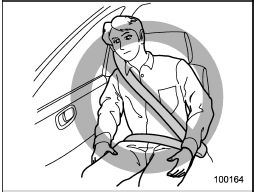

• Do not sit or lean unnecessarily close to either front door. The SRS side airbag is stored in both front seat seatbacks next to the door, and it provides protection by deploying rapidly (faster than the blink of an eye) in the event of a side impact collision. However, the force of SRS side airbag deployment may cause injuries if your head or other parts of the body are too close to the SRS side airbag.
• Since your vehicle is equipped with SRS curtain airbags, do not sit or lean unnecessarily close to the front or rear door on either side. Also, do not put your head, arms and hands out of the window.
The SRS curtain airbag on each side of the cabin is stored in the roof side (between the front pillar and a point over the rear seat), and it provides protection by deploying rapidly (faster than the blink of an eye) in the event of a side impact. However, the force of its deployment may cause injuries if your head is too close to it.
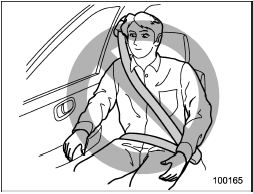

Do not rest your arm on either front door or its internal trim. It could be injured in the event of SRS side airbag deployment.
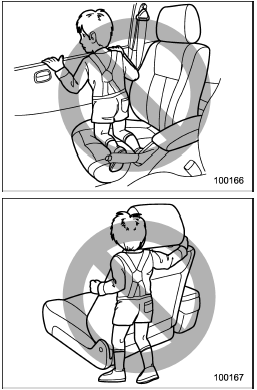

• Never allow a child to kneel on the front passenger’s seat facing the side window or to wrap his/ her arms around the front seat seatback. In the event of an accident, the force of the SRS side airbag deployment could injure the child seriously because his/her head or arms or other parts of the body are too close to the SRS side airbag.
Since your vehicle is also equipped with a front passenger’s SRS frontal airbag, children aged 12 and under should be placed in the rear seat anyway and should be properly restrained at all times.
• Never allow a child to kneel on any passenger’s seat facing the side window or put their head, arms and hands out of the window.
In the event of an accident, the force of the SRS curtain airbag deployment could injure the child seriously because his/ her head is close to the SRS curtain airbag.
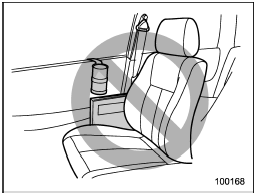

• Do not attach accessories to the door trim or near either SRS side airbags and do not place objects near the SRS side airbags. In the event of the SRS side airbag deployment, they could be propelled dangerously toward the vehicle’s occupants and cause injuries.
• Do not attach a hands-free microphone or any other accessory to a front pillar, a center pillar, a rear pillar, the windshield, a side window, an assist grip, or any other cabin surface that would be near a deploying SRS curtain airbag.
A hands-free microphone or other accessory in such a location could be propelled through the cabin with great force by the curtain airbag, or it could prevent correct deployment of the curtain airbag. In either case, the result could be serious injuries.
• Never hang or place coat hangers or other hard or pointed objects near the side windows. If such items are present when the SRS curtain airbags deploy, they could be thrown through the passenger compartment and cause serious injuries. They could also prevent proper operation of the SRS curtain airbags.
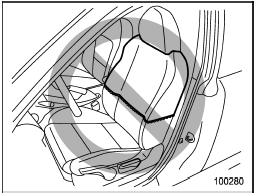

Do not put any kind of cover or clothes or other objects over either front seatback and do not attach labels or stickers to the front seat surface on or near the SRS side airbag. They could prevent proper deployment of the SRS side airbag, reducing protection available to the front seat’s occupant.
See also:
Headlight beam leveler (if equipped)
The vehicle has High-Intensity Discharge (HID) headlights on the low beam setting.
The HID headlights generate more light than conventional halogen headlights.
Therefore a driver of an oncoming ve ...
Braking when a tire is punctured
Do not depress the brake pedal suddenly when a tire is punctured. This could
cause a loss of control of the vehicle. Keep driving straight ahead while gradually
reducing speed. Then slowly pull of ...
Maximum allowable speeds
WARNING
When shifting down a gear, ensure that the vehicle is not travelling at a speed
exceeding the Maximum Allowable Speed for the gear which is about to be selected.
Failure to observe this p ...


